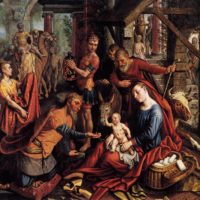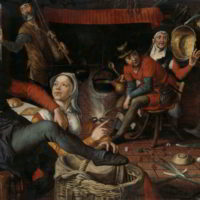| Painting Name | Peasants by the Hearth |
| Painter Name | Pieter Aertsen |
| Completion Date | 1560 |
| Size | 1423 x 198 cm |
| Technique | Oil |
| Material | Wood |
| Current Location | Museum Mayer van den Bergh Antwerp |
Pieter Aertsen was a Dutch painter who had a workshop in Antwerp for several years. He painted altarpieces, but also peasant scenes with a moralizing undertone and kitchen still-lifes with religious themes in the background. He continued this work following his return to Amsterdam in around 1557, concentrating henceforth more on the latter genre. This painting may have been produced during his Amsterdam period.
The subject of the work has long been debated, although we can be sure it is not simply a peasant scene. it was once believed to be a portrait of the artist’s family, but that hypothesis was rejected some time ago. The scene has all the elements of a rural booze-up. Much drink is being consumed, sausages grilled and bacon fried. There are festive biscuits on the table and a tray of waffles. Crowns like the one worn by the boy were used on the Feast of Epiphany, but also during other winter festivities, including Shrove Tuesday. Neither holiday is being celebrated here, however. The bird-cage next to the door on the left tells us that the scene is taking place in a house of ill repute, such as a tavern or brothel. Other elements combine to suggest the latter – the way the young man places his arm around the girl’s waist, the copious eating and drinking, the aggression symbolized by the man with the two weapons, and the foolishness reflected by the king’s crown. Like many of Aertsen’s paintings, this work has both a moralizing and admonitory content, revealed by the presence of three men of different ages, each symbolizing a generation, around one woman.
There is some remarkable innovation in this painting. The figures in the foreground are shown full-length in the middle of the small space, which, together with the monumental format, testifies to the emancipation of non-religious themes in painting around this period.




